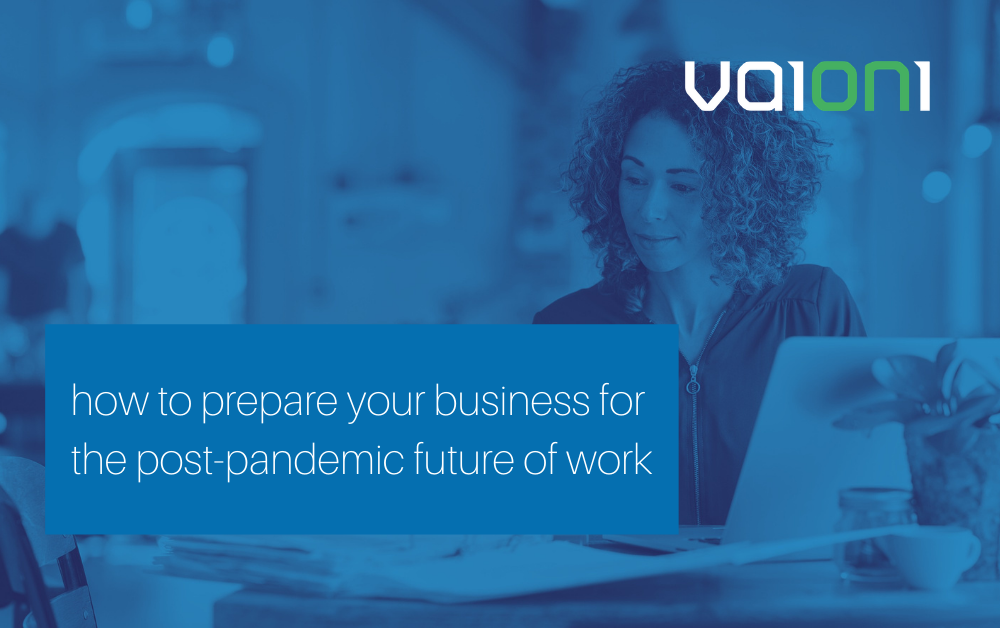Lockdown 3.0 wasn’t the start to 2021 that anyone was hoping for, but the vaccination rollout means there is light at the end of the tunnel. Businesses are starting to think about a return to the workplace, and what form a post-pandemic working model might take. Some may go back to exactly how things were before. Others are likely to back a hybrid model, where staff split their time between remote work and the office.
Hybrid working has some major advantages. Employees want to continue to work from home at least some of the time, and businesses can see benefits in terms of recruitment, retention and productivity. But to make the most of hybrid work, businesses have to be prepared for it.
With that in mind, the Vaioni post-Covid homeworking study is an attempt to start a conversation on what being prepared might look like. We asked SME leaders in a variety of sectors about their experiences during lockdown so far, and the technology that helped them meet the challenge. We wanted to know what might work when short-term measures morph into long-term strategies.
The results were instructive. We’ve summarised some of the main findings below, and you can read the full report here.
Hybrid is on the way
Is hybrid work really the future? The hype around hybrid is probably justified. According to the most recent Future of Jobs report from the World Economic Forum (WEC), the rapid digitisation of many jobs could lead to 44% of workforces operating remotely.
Our own results mirrored these findings. In our study, only 8% of respondents said that staff would work from home all the time, but 60% said they favoured a hybrid model. Employees are keen on hybrid working as a best-of-both-worlds solution and, at the same time, the WEC report suggests that skills gaps could be an impediment to business growth in the next five years. In a competitive recruitment market, no business will want to be the last on the bloc to adopt hybrid working.
But we’re not 100% prepared
On the whole, business made a good fist of lockdown. They got on with it. They were resourceful and creative. But only around half (52%) of our respondents said the technology deployed during the pandemic would be adequate for the future.
That’s fair enough. Temporary fixes are not permanent solutions. But it shows that many businesses looking toward a hybrid future have more work to do. Digging into the detail, we found that bandwidth and reliability issues were the most common problems, while some employees lacked access to their usual tools and applications.
Underperforming technology could undermine long-term plans, especially as remote and hybrid teams will be more dependent on digital tools for basic communication and collaboration. As the WEC report states: “To address concerns about productivity and well-being, about one-third of all employers expect to also take steps to create a sense of community, connection and belonging among employees through digital tools.”
New solutions will be needed
How can employers equip their staff for a future of hybrid work? Our survey offered some suggestions. As far as connectivity is concerned, respondents showed a clear preference for more tailor made homeworker packages. Overall, 76% said they wanted more robust homeworker solutions for all or some staff.
What does that mean in practice? SMEs certainly think remote staff will need better home broadband with a more business-like feel. That might include traffic prioritisation, a better router and improved security. In some cases it might mean dedicated lines, and SLAs need to ensure remote workers are quickly back online if dropouts occur.
Many businesses believe homeworking will also drive demand for full fibre FTTP broadband, especially in households with more than one homeworker.
We didn’t discuss communications technology specifically in the study, but it’s clear that homework solutions that bundle connectivity and security with a unified communications solution will have covered all bases when it comes to equipping staff properly for a future of hybrid work.
Download the full report
We have lots more detail, and a summary of the practical steps businesses can take to prepare for a hybrid future, in the full report. Suffice to say for now that, whether we’re ready or not, Covid is ushering in a new era of work. Businesses that prepare for it now will be in the best position to benefit.


